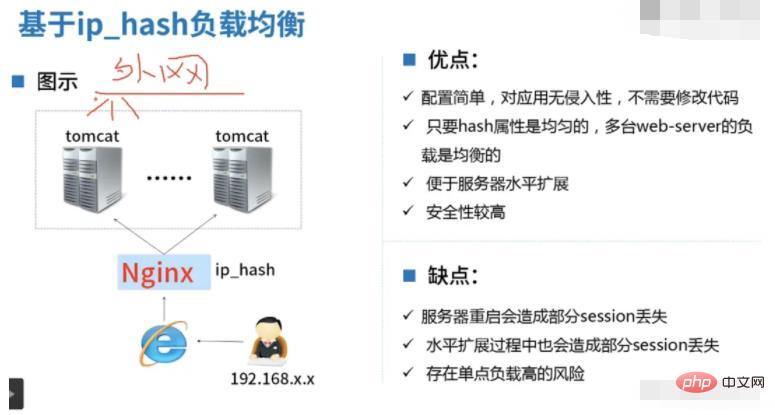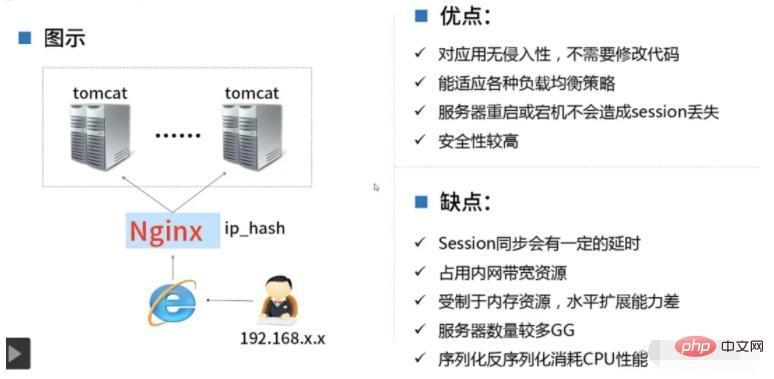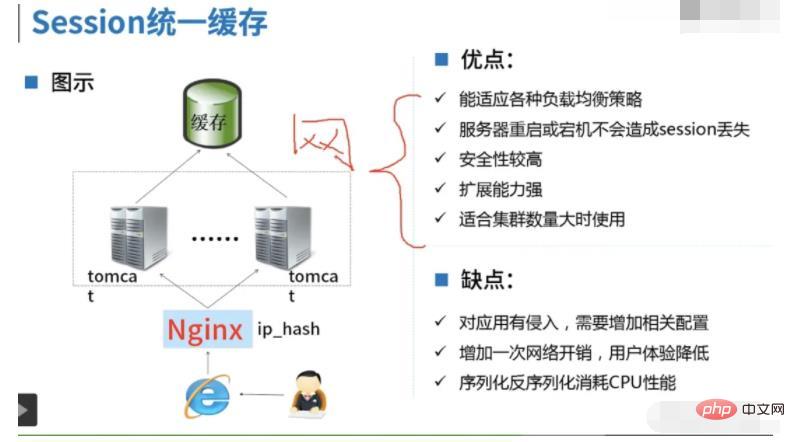Let's talk about four solutions for PHP session sharing
This article will introduce you to the knowledge related to PHP session. Let's start with why this session sharing solution appears. I hope it will be helpful to friends in need~
Understand first Why does this session sharing solution appear?
As the projects of Internet companies are built in microservices and distributed environments, a project may be deployed in several or even many server clusters. At this time, a Question:
When a user has a session, for example, a user logs in to a project. Generally, projects of large companies have Nginx for reverse proxy.
Here Let’s briefly list several reverse proxy strategies commonly used by Nginx:
Polling strategy, weight ratio strategy, ip_hash strategy, and customizable strategies,
In Nginx’s reverse proxy Under the proxy, the user's request is generally distributed to different servers. However, if the user's request is stored on the server A of the request, then the user's session ID is stored in a ConcurrentHashmap of the JVM on the server. Use sessionID as key.
But if a service module requested by the user at this time may need to be called to server B, when the user initiates the request, the user's session ID is not stored on server B at this time, so the user will be asked again Perform a login operation. It may also lead to a situation where the user originally wanted to complete an order operation, but logged in several times.
So the session sharing solution is particularly important in distributed environments and microservice systems. [Recommended learning: "PHP Video Tutorial"]
Solution 1: Nginx-based ip_hash load balancing
In fact, it is how much the requested ip address is to you Take the model from each available server, and then distribute your request to the corresponding server through Nginx's reverse proxy. (Here, the available servers will be put into an array. If the result obtained by taking the modulo is , the request will be assigned to the server with the subscript in the server array.)
Detailed implementation:
You need to make corresponding modifications in the Nginx.conf file, according to your own available server
upstream backend{
ip_hash;
server 192.168.128.1:8080 ;
server 192.168.128.2:8080 ;
server 192.168.128.3:8080 down;
server 192.168.128.4:8080 down;
}
server {
listen 8081;
server_name test.csdn.net;
root /home/system/test.csdn.net/test;
location ^~ /Upload/upload {
proxy_pass http://backend;
}
}The advantages and disadvantages of this implementation:

Solution 2: Session replication based on Tomcat
This solution is actually to copy the generated sessionID to all servers in the system when the user requests it, so as to ensure that when the user requests it, it will be copied from When server A may call a module on server B, it can also ensure that service B also has the user's session ID, so that the user will not be asked to log in again. That solves the problem.
How to implement session replication in specific code?

Advantages and disadvantages of using session replication:

Solution 3: Use Redis as a unified cache for cached sessions
This solution is actually to put the sessionID generated every time the user requests it on the Redis server. Then set an expiration time mechanism based on the characteristics of Redis, so as to ensure that users do not need to log in again during the session expiration time in Redis we set.
How to implement the code:

The advantages and disadvantages of using Redis to implement session sharing:

Solution 4: Combining cookies
In fact, you can also put the session in the cookie, because every time the user requests, his cookie will be put in the request, so this can ensure that every time the user When making a request, it can be guaranteed that the user will not log in twice in a distributed environment.
The above is the detailed content of Let's talk about four solutions for PHP session sharing. For more information, please follow other related articles on the PHP Chinese website!

Hot AI Tools

Undresser.AI Undress
AI-powered app for creating realistic nude photos

AI Clothes Remover
Online AI tool for removing clothes from photos.

Undress AI Tool
Undress images for free

Clothoff.io
AI clothes remover

Video Face Swap
Swap faces in any video effortlessly with our completely free AI face swap tool!

Hot Article

Hot Tools

Notepad++7.3.1
Easy-to-use and free code editor

SublimeText3 Chinese version
Chinese version, very easy to use

Zend Studio 13.0.1
Powerful PHP integrated development environment

Dreamweaver CS6
Visual web development tools

SublimeText3 Mac version
God-level code editing software (SublimeText3)

Hot Topics
 1664
1664
 14
14
 1423
1423
 52
52
 1321
1321
 25
25
 1269
1269
 29
29
 1249
1249
 24
24
 PHP and Python: Comparing Two Popular Programming Languages
Apr 14, 2025 am 12:13 AM
PHP and Python: Comparing Two Popular Programming Languages
Apr 14, 2025 am 12:13 AM
PHP and Python each have their own advantages, and choose according to project requirements. 1.PHP is suitable for web development, especially for rapid development and maintenance of websites. 2. Python is suitable for data science, machine learning and artificial intelligence, with concise syntax and suitable for beginners.
 PHP in Action: Real-World Examples and Applications
Apr 14, 2025 am 12:19 AM
PHP in Action: Real-World Examples and Applications
Apr 14, 2025 am 12:19 AM
PHP is widely used in e-commerce, content management systems and API development. 1) E-commerce: used for shopping cart function and payment processing. 2) Content management system: used for dynamic content generation and user management. 3) API development: used for RESTful API development and API security. Through performance optimization and best practices, the efficiency and maintainability of PHP applications are improved.
 PHP: A Key Language for Web Development
Apr 13, 2025 am 12:08 AM
PHP: A Key Language for Web Development
Apr 13, 2025 am 12:08 AM
PHP is a scripting language widely used on the server side, especially suitable for web development. 1.PHP can embed HTML, process HTTP requests and responses, and supports a variety of databases. 2.PHP is used to generate dynamic web content, process form data, access databases, etc., with strong community support and open source resources. 3. PHP is an interpreted language, and the execution process includes lexical analysis, grammatical analysis, compilation and execution. 4.PHP can be combined with MySQL for advanced applications such as user registration systems. 5. When debugging PHP, you can use functions such as error_reporting() and var_dump(). 6. Optimize PHP code to use caching mechanisms, optimize database queries and use built-in functions. 7
 The Enduring Relevance of PHP: Is It Still Alive?
Apr 14, 2025 am 12:12 AM
The Enduring Relevance of PHP: Is It Still Alive?
Apr 14, 2025 am 12:12 AM
PHP is still dynamic and still occupies an important position in the field of modern programming. 1) PHP's simplicity and powerful community support make it widely used in web development; 2) Its flexibility and stability make it outstanding in handling web forms, database operations and file processing; 3) PHP is constantly evolving and optimizing, suitable for beginners and experienced developers.
 PHP vs. Python: Understanding the Differences
Apr 11, 2025 am 12:15 AM
PHP vs. Python: Understanding the Differences
Apr 11, 2025 am 12:15 AM
PHP and Python each have their own advantages, and the choice should be based on project requirements. 1.PHP is suitable for web development, with simple syntax and high execution efficiency. 2. Python is suitable for data science and machine learning, with concise syntax and rich libraries.
 PHP and Python: Code Examples and Comparison
Apr 15, 2025 am 12:07 AM
PHP and Python: Code Examples and Comparison
Apr 15, 2025 am 12:07 AM
PHP and Python have their own advantages and disadvantages, and the choice depends on project needs and personal preferences. 1.PHP is suitable for rapid development and maintenance of large-scale web applications. 2. Python dominates the field of data science and machine learning.
 PHP vs. Other Languages: A Comparison
Apr 13, 2025 am 12:19 AM
PHP vs. Other Languages: A Comparison
Apr 13, 2025 am 12:19 AM
PHP is suitable for web development, especially in rapid development and processing dynamic content, but is not good at data science and enterprise-level applications. Compared with Python, PHP has more advantages in web development, but is not as good as Python in the field of data science; compared with Java, PHP performs worse in enterprise-level applications, but is more flexible in web development; compared with JavaScript, PHP is more concise in back-end development, but is not as good as JavaScript in front-end development.
 PHP and Python: Different Paradigms Explained
Apr 18, 2025 am 12:26 AM
PHP and Python: Different Paradigms Explained
Apr 18, 2025 am 12:26 AM
PHP is mainly procedural programming, but also supports object-oriented programming (OOP); Python supports a variety of paradigms, including OOP, functional and procedural programming. PHP is suitable for web development, and Python is suitable for a variety of applications such as data analysis and machine learning.




